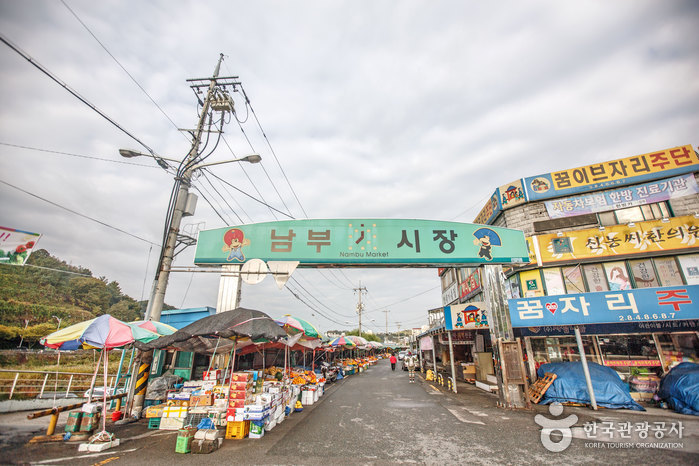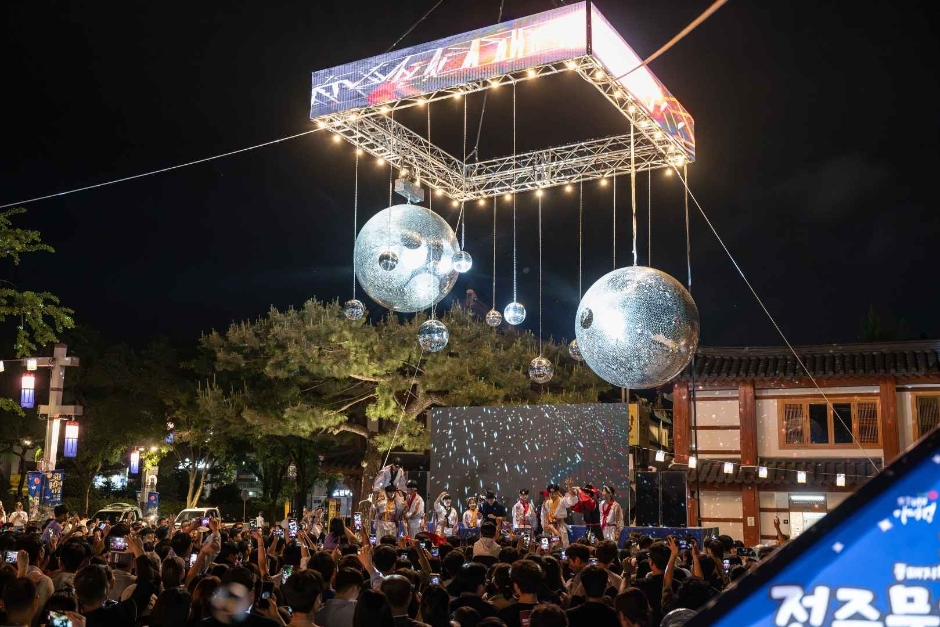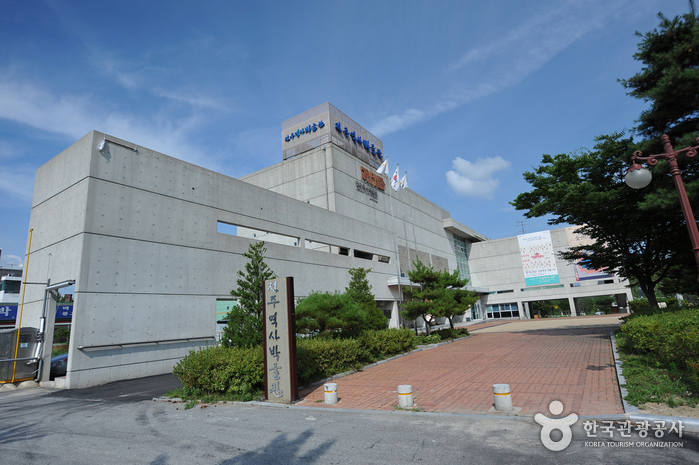Puerta Pungnammun de Jeonju (전주 풍남문)
6.0 Km 4539 2024-04-07
Pungnammun 3-gil 1, Wansan-gu, Jeonju-si, Jeonbuk-do.
La puerta Pungnammun se ubica donde estaba la puerta sur de la antigua Fortaleza de Jeonju. Sus primeras construcciones datan de los años 1734 y 1768, y tras ser parcialmente desmantelada por tareas de planificación urbana, finalmente recuperó su forma original en 1978.
GaEunChae [Korea Quality] / 가은채 [한국관광 품질인증]
6.1 Km 429 2024-04-07
68-13, Hanji-gil, Wansan-gu, Jeonju-si, Jeonbuk-do
+82-10-6345-5267
Gaeunchae is a Handol guesthouse located in Jeonju Hanok Village. Among the four Hanok buildings built by a construction company in 1969, two are being operated as a Gaeunchae guesthouse. While turning it into a lodging place, everything related to a private house was removed, but the original form of the building was revived for guests to feel the beauty of the traditional Hanok.
Jeonju Master's Crafts Center, Jeonju Korean Traditional Wine Museum, Seunggwangjae, Dakjongi Hanji Dolls Workshop, etc. are just a stone's throw away. In particular, the pretty alleys are part of the Hanok Village alley tour course 1 operated by Jeonju City.
In the middle of the yard of Gaeunchae are stones refined by hand years ago, including Macheon Stone, Sago Stone, Goheung Stone, Hwangdeung Stone, etc; the southern yard is paved with flat stones such as old granite, bakseok, and mica. Traditional room doors fitted without using any nails and traditional windows add to the gracefulness of Hanok.
Mercado Nambu de Jeonju (전주 남부시장)
6.1 Km 16960 2024-04-06
Pungnammun 1-gil 19-3, Wansan-gu, Jeonju-si, Jeonbuk-do
Establecido en 1905, el Mercado Nambu de Jeonju es hasta la actualidad un importante punto de comercio, de economía y de transporte para los habitantes de la ciudad de Jeonju. Desde finales de los 60 hasta los años 70, el precio del arroz en general se determinaba en este mercado, mostrando así su gran influencia en los mercados de Corea. Actualmente, unas 800 tiendas se encuentran en el predio. Todos los viernes y sábados hay un mercado nocturno donde se pueden probar platos para picar como morcillas, tortitas y rollitos.
Museo de Licor Tradicional de Jeonju (전주 전통술박물관)
6.1 Km 3321 2024-05-07
Hanji-gil 74, Wansan-gu, Jeonju-si, Jeonbuk-do.
El museo desea recuperar los métodos tradicionales de producción del licor que se adecúe al estilo actual. Para cumplir esta meta, establece clases llevadas a cabo por maestros quienes revelan sus secretos de elaboración del licor, y, de esta manera, los visitantes podrán preparar su propio licor casero. También trata de difundir la cultura tradicional de tomar el licor, elegantemente, como la costumbre que tenían los antepasados. En particular, el museo también se esfuerza para promocionar y propagar el licor tradicional de Corea, de tal manera que establece eventos y festivales periódicamente. Además, los turistas extranjeros que visiten la ciudad de Jeonju tendrán la oportunidad de degustar el licor en este museo.
Siwon [Korea Quality] / 시원 [한국관광 품질인증]
6.1 Km 11550 2024-04-07
45-41, Omokdae-gil, Wansan-gu, Jeonju-si, Jeonbuk-do
+82-10-6520-7840
Situated within Jeonju Hanok Village, Siwon is a hanok experience hall designated by the local government. The names of its individual rooms carry such meanings as “a wish for a life full of love, health and joy”. Each room (except the Gadeukbang) has a small attic where guests can have fun climbing up and down a ladder.
The clay structure with a wood shingle roof is the source of many fond memories for the owner, a permanent fixture of the village, who was born and grew up in the house. The house was once called “the house of persimmon trees in Ssangsiam alley”.
Although the framework of the house was completed in 1954, it has only been open to tourists since it was repaired and renovated in 2014. The house has been fully insulated against draughts and sound-proofed, transforming into a comfortable, cozy guest house that retains the unique beauty of a traditional Korean hanok.
The house’s yard contains a small flower garden and a swing, as well as a space where guests can play tuho, a traditional game in which the players try to throw sticks into a canister, jaegichagi, and other traditional games. In addition, guests can try their hand at woodcraft by cutting and carving pieces of wood into artworks of their own making.
A number of attractions are within walking distance of Siwon, including Gyeonggijeon Shrine, which contains the portrait of King Taejo Seong-gye Yi, the founder of the Joseon Dynasty; Jeondong Cathedral, which features a European architectural design; Omokdae, where King Taejo defeated the Japanese army and held a banquet; Jeonjuhyanggyo Local Confucian School; Namcheon Bridge and Cheonyeonru Pavilion; Nambu Market, a foodies’ paradise; and the Youth Mall
Paseo Cultural Nocturno de Jeonju (전주문화유산야행)
6.1 Km 38547 2024-04-17
Taejo-ro 44, Wansan-gu, Jeonju-si, Jeonbuk-do.
063-232-9937
Este tour se dedica a la preservación y puesta en valor del patrimonio cultural coreano. Jeonju es una ciudad que alberga gran cantidad de sitios que son patrimonio histórico de la época de Joseon. Durante las noches que dura el tour, los visitantes pueden experimentar y conocer de cerca la historia de Corea y apreciar su legado ancestral.
Ilrakdang sarangchae [Korea Quality] / 일락당사랑채 [한국관광 품질인증]
6.1 Km 2872 2024-04-07
15, Choemyeonghui-gil, Wansan-gu, Jeonju-si, Jeonbuk-do
+82-10-3084-6679
A must visit place for tourists in Jeonju, Ilrakdang Sarangchae is located in the middle of the traditional Korean house village of Jeonju. The very first of three enjoyments for noble man, as indicated by Menicus, the existence of parents and brothers with no troubles is what the place is named after. Standing in the garden, you can easily see the stone walls of Gyeonggijeon and also you are within the range of walking distance to Jeondong catholic church, Omokdae, Southern market, Jeonju Hyanggyo, and the wall painting village of Jaman.
The rooms are called, Haengbokchae, Sarangbang, Mitum band, Monday, Tuesday, Wednesday, Thursday, Friday, Saturday, Sunday and so on. Haengbok room 1/2, a living room with furnace, a big sized attic above the living room are shared together, which makes it most suitable for big families or a small group of tourists. The Monday/Tuesday/Friday/Saturday/Sunday rooms all have a small, cozy attic and in every guest room’s wall, column and doors are mainly made of woods which makes them feel very warm. On every morning, in the shared kitchen, simple breakfasts mainly consisting of toasts, jams, coffee and juice are served. All guests are provided with discounts on Korean costume rental(30%), motor bikes(30%) and waengi bean sprout soup with rice (1000KRW). Besides, there are various services such as introduction to tasty restaurants in partnerships with traditional Korean house villages, as well as discounts, and try out of Korean rice cake making experiences and so on.
Museo de Historia de Jeonju (전주역사박물관)
6.1 Km 2520 2024-04-07
Ssukgogae-ro 259, Wansan-gu, Jeonju-si, Jeonbuk-do.
El Museo de Historia de Jeonju se fundó en el año 2002 para hacer llegar al público la larga y fascinante historia de Corea. Este museo está dividido en diferentes áreas de exposiciones y está abierto permanentemente.
La primera exposición es la de la Revolución Agraria Donghak (levantamiento del año 1894 contra los intentos de colonización japonesa). Este suceso cumplió un papel muy importante en el desarrollo de la ciudad de Jeonju. La segunda área de exposición está dedicada a las milicias movilizadas. También hay un área especial dedicada al Movimiento por la Independencia contra el imperio japonés. Hay muchas otras exposiciones con los temas claves y sucesos importantes de la historia de Corea.
Catedral Católica de Jeon-dong en Jeonju (전주전동성당)
6.1 Km 6139 2024-04-06
Taejo-ro 51, Wansan-gu, Jeonju-si, Jeonbuk-do.
La Catedral Católica de Jeon-dong fue construida en 1914 al estilo occidental y fue designada como Sitio Histórico. Es la estructura del estilo occidental más grande de las provincias de Jeollanam-do y Jeollabuk-do. La catedral es elegante con sus paredes de ladrillos y lo más encantador es la entrada y la torre de campana. La entrada de la iglesia tiene una forma arqueada que le da un toque bizantino, mientras que la pequeña torre de campana ubicada en el centro agrega una belleza singular. Desafortunadamente, algunas partes de la catedral fueron destruidas por un incendio en 1988.
Jeonju hanok house [Korea Quality] / 전주한옥숙박체험관 [한국관광 품질인증]
6.1 Km 1623 2024-04-07
56-1, Eunhaeng-ro, Wansan-gu, Jeonju-si, Jeonbuk-do
+82-10-3659-0055
Jeonjuhanok Korean House is a traditional Korean house built more than 60 years age, and it was recently remodeled for visitors to see and experience an old traditional Korean house. It’s conveniently located on the street called "Eunhaeng-ro" right in the middle of Jeonju Hanok Village for those visiting the area to take a tour of the hanok village. Although it's in the middle of the village, it's quiet inside because it's located at the end of a long, wide alley, which has the feel of an art gallery thanks to the lighting. There is a table in the yard in front of the ‘ㄱ’-shaped house. Behind the house is a café where breakfast is served. The house has an open space between the rooms called "toetmaru", which serves as a living room as in all traditional Korean houses. It’s where Koreans used to rest under the warm sunlight in the old days. The guests must pass through this "toetmaru" to get to the roms.
Jeonjuhanok Korean House has seven "ondol (floor-heated)” rooms with a loft. The rooms are clean and have a simple interior with a wooden ladder to the loft, which is a favorite place for most kids staying here with their parents. Each guestroom is furnished with a water purifier. The guesthouse serves toast, caffe Americano, fruits, and tea for breakfast.



![Siwon [Korea Quality] / 시원 [한국관광 품질인증]](http://tong.visitkorea.or.kr/cms/resource/24/2596624_image2_1.jpg)

![Ilrakdang sarangchae [Korea Quality] / 일락당사랑채 [한국관광 품질인증]](http://tong.visitkorea.or.kr/cms/resource/57/2596657_image2_1.jpg)


![Jeonju hanok house [Korea Quality] / 전주한옥숙박체험관 [한국관광 품질인증]](http://tong.visitkorea.or.kr/cms/resource/90/2531490_image2_1.jpg)
 Español
Español
 한국어
한국어 English
English 日本語
日本語 中文(简体)
中文(简体) Deutsch
Deutsch Français
Français Русский
Русский